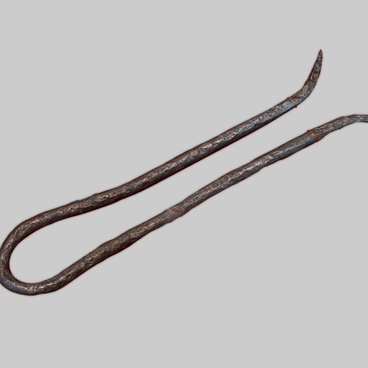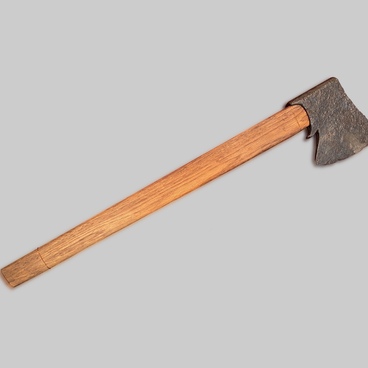Pyorka is the name of a flat wood drill. In the documents of XVII century the drill is called ‘buravets’ (borer) or ‘buravchik’ (gimlet). Such drill was operated manually, holding the wooden handle with two hands and rotating it. The hand spiral flat drill in the museum permanent exhibition was found in Kuznetsk ostrog excavations. PyOrka was used to drill 9 mm holes. A small groove was designed for cuttings discharge. The drill is made of low carbon steel using ordinary pressure metal treatment.
As processes developed, the drill became one of the most universal tools. Over several millenniums, an ordinary wooden stem operated manually or by the bow string developed into a head of hand and automatic tools for making holes in various materials. As a rule, the drill is a cylinder stem with a spiral groove with a razor edge. Its point has sharpened razor edges that rotate to cut into the processed material. Sharpened side edges shape the side surface of the hole and the grooves discharge the cuttings from the processing area.
Cosmic iron and self-originated copper and other alloys that were added to the toolbox of ancient blacksmiths allowed them to manufacture the first metal drills. Initially, they were cone-shaped, square or triangular. In order to drill a deep hole, much effort was required, increasing the risk of breaking the tool – despite their sharp edges, the drills were rather crumpling than cutting the wood fibers. To facilitate the work, the drills were improved: a larger head was added, and then a large handle that was more convenient to hold.
The drills were both installed into the driving tools and hand operated. In ancient times the wood drills were called ‘napArye’, another name for them was ‘perovOye’. Its principal distinctive feature was the availability of just one cutting edge.
The arrow-headed drill was used by carpenters. The blacksmith forged the stem, shortened the working part by one third and shaped the cutting edge through round spreading. That drill became a significant step forward vs. tbe triangular and square drills — now the razor cut the fibers instead of crumpling them. When the arrow-headed drill was operated for a long time, removal of cuttings from the hole was time-consuming.
As processes developed, the drill became one of the most universal tools. Over several millenniums, an ordinary wooden stem operated manually or by the bow string developed into a head of hand and automatic tools for making holes in various materials. As a rule, the drill is a cylinder stem with a spiral groove with a razor edge. Its point has sharpened razor edges that rotate to cut into the processed material. Sharpened side edges shape the side surface of the hole and the grooves discharge the cuttings from the processing area.
Cosmic iron and self-originated copper and other alloys that were added to the toolbox of ancient blacksmiths allowed them to manufacture the first metal drills. Initially, they were cone-shaped, square or triangular. In order to drill a deep hole, much effort was required, increasing the risk of breaking the tool – despite their sharp edges, the drills were rather crumpling than cutting the wood fibers. To facilitate the work, the drills were improved: a larger head was added, and then a large handle that was more convenient to hold.
The drills were both installed into the driving tools and hand operated. In ancient times the wood drills were called ‘napArye’, another name for them was ‘perovOye’. Its principal distinctive feature was the availability of just one cutting edge.
The arrow-headed drill was used by carpenters. The blacksmith forged the stem, shortened the working part by one third and shaped the cutting edge through round spreading. That drill became a significant step forward vs. tbe triangular and square drills — now the razor cut the fibers instead of crumpling them. When the arrow-headed drill was operated for a long time, removal of cuttings from the hole was time-consuming.
That is why the drills gradually became screw shaped. It allowed reducing the time of removing the cuttings by turning the tool in the rotational direction.
The wood pulp has a beautiful natural color and various types of texture, good thermal insulation and water resistance. Low density of wood made it convenient for processing. That is why it was used to construct dwellings, city walls and fortifications, churches and bridges. Household items were also made of wood: buckets, barrels, spoons, coops, salt cellars, bowls and cups. Wood processing crafts were developing in the areas rich in forests, and traditions were established. Each nation developed its own approach to wood processing, identified their preferences in fabrication of wooden items and decoration techniques.
The wood pulp has a beautiful natural color and various types of texture, good thermal insulation and water resistance. Low density of wood made it convenient for processing. That is why it was used to construct dwellings, city walls and fortifications, churches and bridges. Household items were also made of wood: buckets, barrels, spoons, coops, salt cellars, bowls and cups. Wood processing crafts were developing in the areas rich in forests, and traditions were established. Each nation developed its own approach to wood processing, identified their preferences in fabrication of wooden items and decoration techniques.



